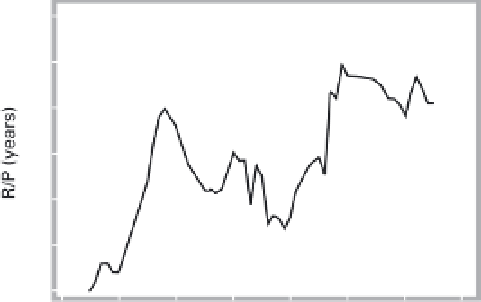Environmental Engineering Reference
In-Depth Information
8.2 (a) R/P ratio for global crude oil, 1945-2005 (Smil
2003; BP 2006). (b) Map showing the areas of nations and
continents proportional to the size of their conventional crude
oil reserves (excluding oil sands). Constructed from data in BP
(2006).
that the 1996 P50 reserves of conventional oil were only
850 Gbbl, almost 17% lower than the Oil & Gas Journal
total of 1019 Gbbl and nearly 27% below the World Oil
figure. The key reason for this discrepancy was a large
jump in reported world oil reserves that came about not
because of new discoveries but as a result of an account-
ing upgrade performed in 1987 by six OPEC members,
reported in Oil & Gas Journal (''New data'' 1987). Iraq
and Iran were at war in 1987 and reported huge reserve
additions over the previous year: Iraq's estimate was up
by 112%, Iran's by 90%. Upward revaluations of existing
reserves are to be expected, but Campbell and Laherr`re
(1998) concluded that the magnitude of this increase (a
27% jump compared to 1986) and its timing in the wake
of weakened world oil prices made it a prime example of
politically generated reserve numbers, and that the totals'
validity could be verified only if the relevant records of
state oil companies were open for inspection.
Global estimates of undiscovered conventional crude
oil resources have been even more contentious (Masters,
Attanasi, and Root 1994; C. J. Campbell 1997; Odell
1999; USGS 2000; Deffeyes 2001; Odell 2004). Scores
of estimates of ultimately recoverable oil have been pub-
lished since 1940, and all but four totals published since























































